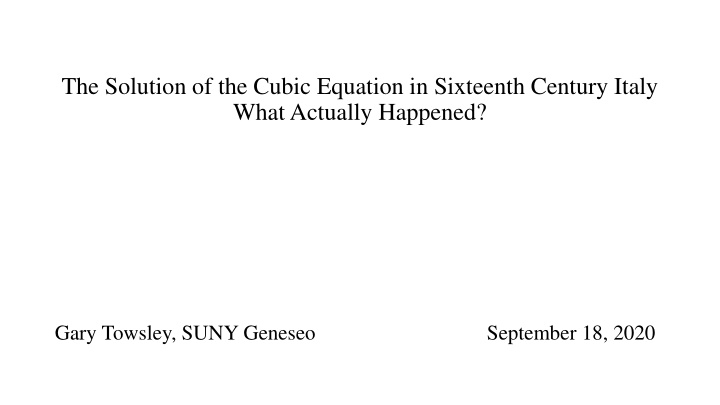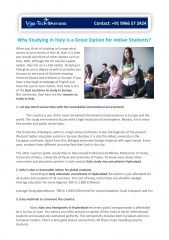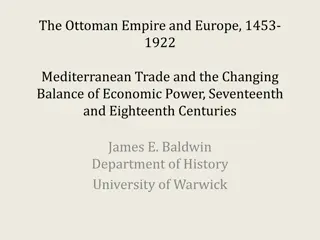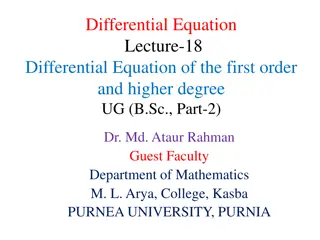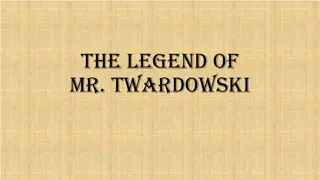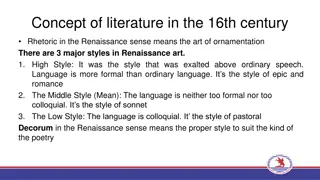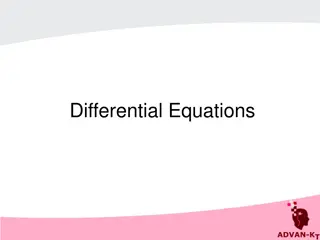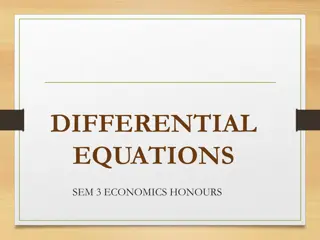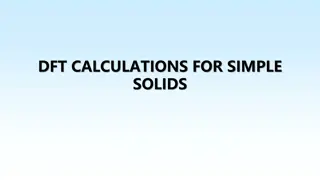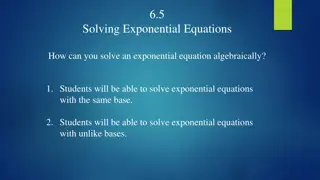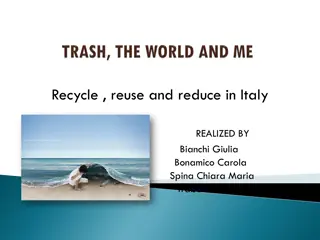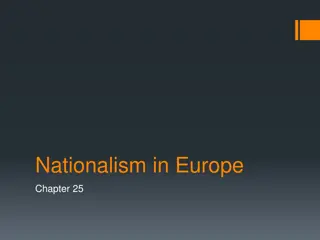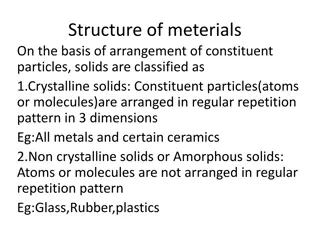The Solution of Cubic Equations in 16th Century Italy
Scipione del Ferro's pivotal solution of the cubic equation around 1510 marked a significant advancement in algebraic understanding. Explore the historical context, importance, and implications of this breakthrough in mathematics.
Download Presentation

Please find below an Image/Link to download the presentation.
The content on the website is provided AS IS for your information and personal use only. It may not be sold, licensed, or shared on other websites without obtaining consent from the author.If you encounter any issues during the download, it is possible that the publisher has removed the file from their server.
You are allowed to download the files provided on this website for personal or commercial use, subject to the condition that they are used lawfully. All files are the property of their respective owners.
The content on the website is provided AS IS for your information and personal use only. It may not be sold, licensed, or shared on other websites without obtaining consent from the author.
E N D
Presentation Transcript
The Solution of the Cubic Equation in Sixteenth Century Italy What Actually Happened? Gary Towsley, SUNY Geneseo September 18, 2020
Around the year 1510, Scipione del Ferro (1465 1526), a professor at the university of Bologna solves the cubic equation of the form : 3x px q + =
Questions 1. What does it mean to solve a cubic equation (algebraically)? 2. Why is such a solution important? 3. Why did the solution happen when it did?
What is a Cubic Equation? What does it mean to Solve a Cubic Equation?
What is a Cubic Equation? + = 3 6 20 x x
What is a Cubic Equation? + = 3 6 20 x x A Cube and six Things is twenty N umbers
+ = = 3 6 20 + + 0 x x + = 2 ( x 2)( 2, 2 10) 0 x x x i 1 3 , 1 3 i
Scipiones Actual Solution + = 3 6 20 For the cubic the solution he computed was not 2 but which a calculator will tell you is 2. x x + 3 3 108 10 108 10
Quadratic Equations Problems we recognize as quadratic equations have been solved for at least the last 4,000 years: A number added to its reciprocal is 4. What is the number? The area of a rectangle is 40 and its perimeter is 28. What are its length and width? I have added a square and 4 times its side. The result is 21. What is the side?
A number added to its reciprocal is 4. What is the number? 1 x + = 4 x The area of a rectangle is 40 and its perimeter is 28. What are its length and width? 40, LW L W = + = 28 I have added a square and 4 times its side. The result is 21. What is the side? 2 4 x x + = 21
Modern Solution A number added to its reciprocal is 4. Find the number. 1 x + = 4 x + = 2 1 4 4 + = x x 2 1 0 x x 4 12 = = 2 3 x 2
Ancient Mesopotamian Solution 4, the sum, is multiplied by itself: result 16 From 16 subtract 4: result 12 Take the square root of 12: result Add 4 and :result Divide by 2: result the desired number 12 + 12 4 12 + 2 3
Modern Explanation 1 x + = 4 x 2 1 x 1 x + = + + = 2 2 16 x x 2 2 1 x 1 x 1 x 16 4 = + + = + = = 2 2 2 4 2 12 x x x 2 2 1 x = 12 x 1 x 1 x + + = = + 2 4 12 x x x = + 2 3 x
Solutions to Quadratics were Geometric Variants on the above method a b + = a b 2 2 ( ) 4 ( ) ab + = 2 x ax b Literally Completing the Square 2 2 2 a a a + + = + = + 2 x ax x b 4 2 4 2 a a + = + x b 2 4
Muhammed al-Khwarizmi (780 850) Al-Jabr and al-Muqabala Solutions of all quadratic equations (only positive solutions) Geometric Methods Forms of Quadratics: (all coefficients are positive) = + + = = 2 x b = 2 x ax b 2 x b ax + 2 x ax b
What About? = 2 x ax Divide out the x. + ax b + = 2 0 x No positive roots.
What about Cubic Equations? Considered by Mesopotamians but only solved approximately Considered by Archimedes for specific Geometric Problems Considered by Diophantus of Alexandria but only for situations where the solution was already known and the roots were rational numbers
Omar Khayyam (1048 1131) Classification of all cubics into two types: Those reducible to quadratics for example Fourteen Irreducible Cubics: Three term cubics Four term cubics x + = 3 2 x ax bx = 3x c + ax = 3x 3 bx 2 c + = + bx c
Reducible Cubics = + + = = 3 2 3 , x ax x bx = 3 2 x ax bx = 3 2 x bx ax + 3 2 x ax bx
14 Irreducible Cubics = + = = + + = 3 x c + = = + = + = 3 2 3 3 2 3 , , , , x c ax + = + + x c bx + + = + x ax c x bx c 3 2 3 x ax c x bx c + = + + + = + 3 2 3 2 3 2 , , , , x ax bx c x c ax + = bx x bx ax c + + = 3 2 3 2 3 2 x ax bx c x bx c ax x ax c bx 3 2 x ax bx c
Omar Khayyams Solutions For Reducible Cubics he gave al-Khwarizmi s solutions with Euclidean Proofs For Irreducible Cubics he showed that solutions existed using Conic Sections These solutions did not result in numerical (or algebraic) solutions except for the very first case: = 3x c
Example of Solutions via Conics + = 3 6 + 20 = x x 2 ( 6) 20 x x 20 x + = 2 6 x Left hand side is a parabola, right hand side is a hyperbola Solution is a point of intersection of the conics His solutions were much more complicated than the above example appears to be
Khayyams Solutions to Irreducible Cubics Used Conics by Apollonius of Perga (250 175 BCE) Gave possible number of positive roots in each case Analytic or Coordinate Geometry is 6 centuries in the future Omar Khayyam was not satisfied with his results, he had not found algebraic solutions to any of the cubics except the case = 3x c
Leonardo of Pisa (Fibonacci) (1170 1240) As a youth he traveled with his merchant father around the Mediterranean and learned the mathematics of al-Khwarizmi. He wrote Liber Abacci (Book of Computation) 1. Explained Hindu-Arabic Base 10 Numeration 2.Presented algorithms for all the arithmetic operations 3. Presented and solved a great number of problems using these numerals, proportions, and the algebra of al-Khwarizmi
Cossist Algebra Building on the work of Fibonacci and others, the cities of Central and Northern Italy set up Abacus Schools as part of the standard education system and thus developed a highly numerate workforce. The most advanced topics in this kind of school involved Cossist Algebra , the name coming from the word cosa or thing which stood for the unknown in an equation. co - cosa (x) ce - censo or square (x2) cu - cubo or cube (x3).
Luca Pacioli (1445 1517) Franciscan Monk, friend of Leonardo da Vinci and Piero della Francesca Wrote Summa (1494) compendium of all known mathematics of the time In the Summa he stated that many mathematicians had worked on finding algebraic solutions to the irreducible cubics but none had succeeded beyond solutions by trial and error. Perhaps it was an impossible task.
Around the year 1510, Scipione del Ferro (1465 1526), a professor at the university of Bologna solves the cubic equation of the form : 3x px q + =
Mathematicians who worked on Cubics Scipione del Ferro (1465 1526) Nicolo Fontana (Tartaglia) (1499 1557) Girolamo Cardano (1501 1576) Ludovico Ferrari (1522 1565)
Ars Magna (The Great Art) Published by Cardano in 1545 (with some help from Ferrari and Tartaglia) Presented algebraic solutions to all cubic equations One chapter to each form Presented algebraic solutions to quartic equations (due to Ferrari) Found negative roots to cubics and quartics Found complex roots (but they were useless)
Cardano Solves a Cubic Chapter 11 of Ars Magna On the Cube and First Power equal to the Number For example, let GH3plus 6 times its side GH equal 20 + = 3 6 20 He solves x x
Step 1 Cardano gives a Euclidean proof that if A and B are lengths such that 3 times the area of the rectangle AB is 6 and the difference of the volumes of the two cubes A3 B3 is 20, then the length A B satisfies the given equation.
Step 2 Cardano produces what he calls a rule namely a recipe or an algorithm to find the required lengths A and B. He offers no proof of this rule. The Rule: Cube one-third the coefficient of x; add to it the square of one-half the constant of the equation; and take the square root of the whole. You will duplicate this, and to one of the two you add one-half the number you have already squared and from the other you subtract one-half the same. Then subtracting the cube root of the second from the cube root of the first the remainder of what is left is x.
Why didnt Cardano prove Step 2? 1. It involved squaring a volume which clearly does not exist geometrically (clearly at the time). 2. The derivation used Cossist Algebra which Cardano rather believed was outside the realm of proof.
+ = 3x Cardano s Formula for px q 2 3 2 3 q p q q p q x = + + + 3 3 4 27 2 4 27 2
+ = 3 6 20 x x Our Example p = 6, q = 20 2 3 2 3 q p q q p q + + + = + = 3 3 108 10 108 10 2 3 3 4 27 2 4 27 2
How did Cardano find his Rule? x a b ab ab = = = = 3 6, 2 3 3 20 a b ( ( ( ) ) ) 2 = = + 3 3 6 3 3 a b 6 400 2 a b a b ( ) 2 2 + = = + 3 3 3 3 a b 3 3 4 432 a b a b + = = 3 3 432 2 108 a b + + = = 20 2 108 + 3 3 3 3 3 2 a b a b a
+ = = 3 3 3 3 3 ( ) 2 2 108 20 a b a b b = 108 10, + = + 3 3 108 10 a a = 108 10, = 3 3 108 10 b b = a b = + = 3 3 108 10 108 10 2 x
Why is this important? 1. It solved a problem that had been unsolved for many thousands of years. 2. The quartic equation was solved almost immediately afterwards using the solution to the cubic. 3. The solution gave great impetus to the development of the symbolic algebra we use today. (Bombelli, Vieta, Fermat, Descartes, etc.) 4. Coordinate Geometry is in many ways a byproduct of this solution.
Why did the Solution first happen around 1510? The solution to the cubic found by del Ferro required two kinds of mathematics: Euclidean Geometry (The Mathematics of the University) Cossist Algebra (The Mathematics of Commerce) They first came together in Italy around this time.
What about the Quintic Equation? + = 5 1 0 x x Another story, another talk.
